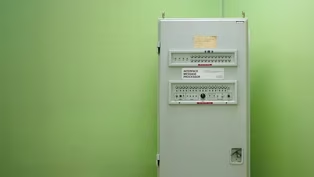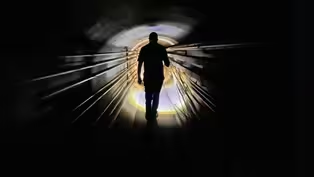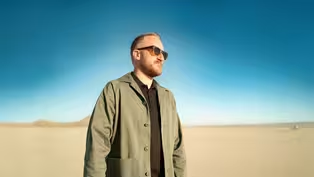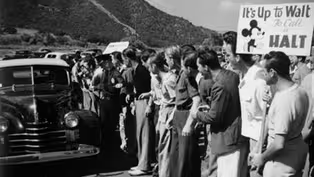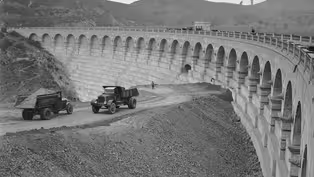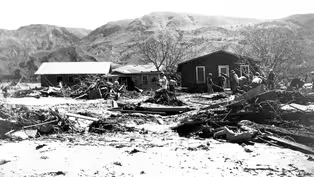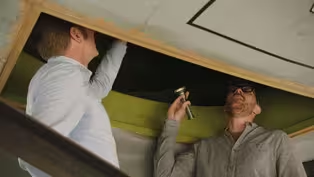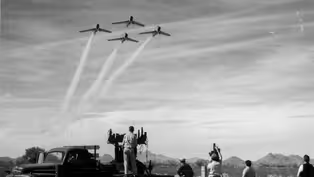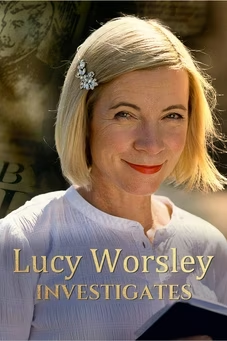
How This Contraption at UCLA Sent the First DM
Clip: Season 7 | 9m 19sVideo has Closed Captions
At UCLA Professor Leonard Kleinrock reveals proof of when the internet was born.
Nathan Masters heads to the UCLA Library Special Collections to visit Professor Kleinrock and go through his collection. Kleinrock reveals the one document that has written proof of the date and time that “LO” was sent. The only proof of this huge moment in our computer science history.
Problems playing video? | Closed Captioning Feedback
Problems playing video? | Closed Captioning Feedback
Lost LA is a local public television program presented by PBS SoCal

How This Contraption at UCLA Sent the First DM
Clip: Season 7 | 9m 19sVideo has Closed Captions
Nathan Masters heads to the UCLA Library Special Collections to visit Professor Kleinrock and go through his collection. Kleinrock reveals the one document that has written proof of the date and time that “LO” was sent. The only proof of this huge moment in our computer science history.
Problems playing video? | Closed Captioning Feedback
How to Watch Lost LA
Lost LA is available to stream on pbs.org and the free PBS App, available on iPhone, Apple TV, Android TV, Android smartphones, Amazon Fire TV, Amazon Fire Tablet, Roku, Samsung Smart TV, and Vizio.
Providing Support for PBS.org
Learn Moreabout PBS online sponsorshipWe were extremely lucky.
That first message was lo, as in, lo and behold.
I added that later.
[music] In this box is a pretty important document.
You bet.
Let's take a look.
It's perhaps the most important document of the internet.
From the earliest days to the first message and beyond.
It's the only record of that first message.
There was no camera.
It used to be in the birthplace of the internet, in the engineering building.
I would talk about it and show it to all the visitors.
One day, one of the archivists came by to see the event.
They said, "You're touching that document with your greasy fingers?"
Might as well be a Gutenberg Bible, right?
He took it away, and I never saw it again.
Well, here it is.
I think you're welcome to come here and look at it whenever you want.
Thankfully, we have the privilege of looking at it with you.
It's a special privilege to be able to see it, -I'll tell you.
-It really is.
Let's take a look.
This is a logbook.
Imp log, I-M-P.
Interface Message Processor.
You call those things a router.
You notice it's stolen from SDS, Scientific Data System.
Our host computer was built by them.
They had a whole formal set of documentation, including notebooks.
We stole one of their blank notebooks and created what we call a very nice engineering log.
You can see, these are nerds.
These are not professionals.
This was never intended to be a historical document of the utmost importance.
There's just random scribblings here with just jotted notes on it.
Exactly.
The internet was never supposed to be an important notebook either.
We're in the middle of October 1969 here.
Here it is.
There it is.
That's the key page.
On October 29th, 1969.
10.30 at night, Charley Kline, my programmer, who was keying in the words, entered, 'Talk to SRI Host to Host'.
Sorry, Stanford Research Institute.
Right.
Not Stanford University, by the way.
It's a laboratory related to them.
It's the only record ever of that first message.
Anything that they did on this machine would be entered in this log.
The history is interesting.
One of my programs, a PhD student, Jon Postel, he was a disciplinarian.
One of his classmates.
He said, "You guys better keep a record of what you're doing."
He put the first entry in, Jon Postel.
He said, blah, blah.
He was the one who was telling his fellow students and programmers, "You better take care."
If not for Jon Postel, then we might not have any record of this momentous event.
You're quite right.
We were just a bunch of grad students, professors, engineers doing a job.
Who keeps records?
I don't imagine you got a call from President Nixon.
There wasn't a choir of angels that came down and started singing.
We didn't have a good message.
What was our message?
Well, to preface it, what was Samuel Morse's message for Telegraph?
'What hath God wrought?'
What a Biblical, powerful message.
Alexander Graham Bell, "Come here, Watson, I need you."
And your friend up in the moon?
"A giant leap for mankind."
Those guys understood PR and publicity.
All we wanted to do was log in, so we didn't have a good message.
Except you got lucky.
The story is, as you all know, we wanted to log in from UCLA to the machine up at SRI, 350 miles to the north, to prove the functionality of this network we were building.
What was the functionality?
To sit at one machine, log on through the network to a machine far away, and use that machine there.
Now, you look at me and say, "Well, of course, everybody does, every time they go to a web search."
Well, in those days, machines didn't talk to each other.
To be able to do that was the essential thing we wanted to prove.
Now, we had two nodes in October, so we could log in from UCLA to SRI and use the function there.
You have to log in.
How do you log in?
You have to type L-O-G, and the machine up north, the SRI machine, knows what's happening.
It'll type the IN field.
Let's go.
I had Charley Kline down at my end and Bill Duval up at the SRI end, and they're going to send this little login.
To be sure, you don't see packets so to make sure what was going on, we put a telephone connection between the two of them so they could talk.
Now, look at the irony here.
We're going to use a telephone network to destroy the telephone network, and in fact, we did.
Today, every telephone call you make goes over the internet.
It's all IP.
Charley typed the L, and he asked, "You got the L?"
Bill said, "Yes, got the L."
Typed the O, "You got the O?"
"Yes, got the O."
Typed the G, "You got the G?"
Crash.
Network went down.
The moment the internet was born, the network crashed.
Immediately.
As you point out, we were extremely lucky.
That first message was low, as in, LO and behold, I added that later.
How many people know that the birthplace of the internet is in Los Angeles, right here at UCLA?
Not only that, the students walking around the campus don't know that.
The birthplace of the internet is what, a 10-minute walk across campus?
Let's go take a look.
Absolutely.
You'll enjoy it.
Wow.
I feel like I just stepped back in time.
You did, and it's a holy place.
Then this is the machine that did it.
This is it.
This is the most important thing in this room.
This is the first piece of internet equipment ever.
The IMP, the devilishly named IMP.
Yes, in fact.
We call it an interface message processor, of course.
He liked acronyms.
First router.
You call it a router, too.
The first router.
It's a special machine.
You notice it's IMP number one, and it's a military hardened machine.
It's meant to be military hardened, stand in the corner unattended, and run forever.
Which is appropriate.
This is a military project piece of equipment, right?
ARPA was funded by the, it was part of the Department of Defense.
It had a quarter in the Pentagon.
It was not for military purposes that we built the ARPANET.
That's probably a common misconception.
Exactly.
Eisenhower wanted to bring up the American capability and technology after Sputnik showed that we were not primal.
We have the Soviets to thank for the internet.
In some sense, yes.
It's a wonderful machine.
It's got all these switches here.
Inside, it's so ugly, it's beautiful.
I see what you're saying.
-That's so ugly, but yes.
-Beautiful ugliness.
There's the Honeywell name all over there.
Yes.
The Honeywell DDP-516.
You had a computer in this room?
Yes.
This connected to that computer and then this connected to another IMP at SRI and then that connected to another computer at SRI.
That's the significance of this is that it allowed a computer here to talk to a computer there.
Exactly.
The idea was, in those days, we wanted to allow people to sit at one machine, log in through this network to a remote machine, and use it there.
In those days, that was unique.
Today, you do that every time you make a web search.
There are a lot of computers to talk to each other with users using the applications remotely, was the novelty.
This sent the first internet transmission ever.
Today, the internet is literally coursing through our bodies right now.
It's pervasive.
It pervades the entire world.
Once people realized not only could other people use theirs, but they could use all the other machines out there, it was a win-win situation.
It took a while for that to happen.
The idea of basically sharing resources was the whole idea, which allowed this network to function so well, as opposed to this voice network, which dedicated a sequence for the entire duration.
That was the whole concept.
You mentioned the sharing of computers.
It was the sharing of communication, high, expensive communication links.
You build a bunch of these, deploy them, and connect computers to them.
Instead of making every computer take on this functionality and do surgery on the computers.
By the way, the idea of this dynamic resource sharing of links, when I'm not using it, you can, was the basis of my PhD dissertation at MIT, years before anybody wanted an ARPANET.
Nobody cared.
ATT said it wouldn't work.
Even if it did, they wanted nothing to do with it.
That's the environment.
Finally, ARPA said, "We want one to connect our research computers."
The world wasn't ready at the time for the internet.
It took some forward-thinking people.
It did, but they didn't think of an internet.
It was a research network until things happened 20-odd years later when spam came around, and that's a whole other story.
[laughs] Sure.
[music]
How This Contraption at UCLA Sent the First DM
Video has Closed Captions
Clip: S7 | 9m 19s | At UCLA Professor Leonard Kleinrock reveals proof of when the internet was born. (9m 19s)
Lost LA Season 7 (Extended Preview)
Preview: S7 | 1m | Lost LA’s new season explores hidden SoCal history through rare documents, photos, and stories. (1m)
Preview: S7 | 35s | The new season of Lost LA premieres Jan 7, exploring Southern California's hidden history. (35s)
Inside the Animation Research Library
Video has Closed Captions
Clip: S7 Ep4 | 2m 58s | Nathan goes frame by frame through the Walt Disney Animation Research Library. (2m 58s)
A Hollywood Dream Job Made Real
Video has Closed Captions
Clip: S7 Ep4 | 4m 10s | Animotor Floyd Norman always knew that he wanted to work at Walt Disney's Hollywood Studio. (4m 10s)
Video has Closed Captions
Preview: S7 Ep4 | 30s | Uncover Disney’s LA roots and how the city became the birthplace of modern animation. (30s)
Why the Hollywood Reservoir Was Hidden After the St. Francis Dam Disaster
Clip: S7 Ep3 | 1m 32s | The Hollywood Dam was meant to be celebrated. After the St. Francis Dam disaster, it was hidden. (1m 32s)
When the St. Francis Dam Collapsed (Preview)
Preview: S7 Ep3 | 30s | Trace the devastation of the 1928 St. Francis Dam collapse and its deadly flood. (30s)
Preview: S7 Ep1 | 30s | The Space Shuttle Endeavour’s journey is traced from its origins. (30s)
In Downey, A Space Shuttle Hides in Plain Sight
Video has Closed Captions
Clip: S7 Ep1 | 3m 48s | A space shuttle mock-up sits in a maintanance yard in The City of Downey, awaiting its moment. (3m 48s)
How One Spanish Word Saved Countless Lives
Clip: S7 Ep3 | 6m 14s | Nathan learns the heroic efforts of Officers Edwards and Baker during the St. Francis Dam Disaster. (6m 14s)
The Hidden Film Studio Behind Atomic History
Video has Closed Captions
Clip: S7 Ep2 | 3m 57s | Nathan interviews photographer Ken Hackman about his role filming atomic tests at Lookout Mountain. (3m 57s)
Exploring the Forgotten Legacy of Santa Paula’s Spanish-Language Newspaper
Clip: S7 Ep3 | 4m 57s | Nathan uncovers the history of Santa Paula’s Spanish-speaking communities with Professor Alamillo. (4m 57s)
Preview: S7 Ep2 | 30s | How Cold War vigilance and secrecy shaped Southern California culture. (30s)
Cold War Fallout Shelter Uncovered in Los Angeles Backyard
Video has Closed Captions
Clip: S7 Ep2 | 6m 14s | Los Angeles Historian, DJ Waldie sends Nathan down into a Cold War Era shelter hidden in a backyard. (6m 14s)
Astronaut Danny Olivas and the Legacy of Space Shuttle Endeavor
Video has Closed Captions
Clip: S7 Ep1 | 6m 3s | Nathan meets with astronaut Danny Olivas at Griffith Observatory. (6m 3s)
Providing Support for PBS.org
Learn Moreabout PBS online sponsorshipSupport for PBS provided by:
Lost LA is a local public television program presented by PBS SoCal
